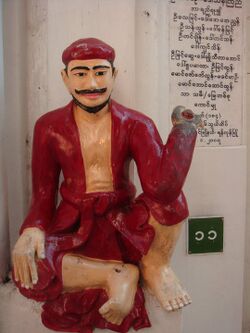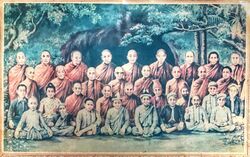Religion:Weizza
A weizza or weikza (Burmese: ဝိဇ္ဇာ, Pali: vijjādhara[1]) is a semi-immortal supernatural figure in Buddhism in Burma associated with esoteric and occult practices such as recitation of spells, samatha and alchemy. The goal of this practice is to achieve the timeless state of the weizza, who awaits the appearance of the future Buddha, Metteya.[2]
Weikza practices are less common than merit-making practices or vipassanā meditation.
Etymology
The word weizza (ဝိဇ္ဇာ) comes from the Pali word vijja, which means “knowledge” or “wisdom.”[3]
Weizzas in the historical tradition
Aside from epigraphs, there are no local Indic or vernacular compositions that have been securely dated to pre-Pagan Burma. However, there are some later attributions of texts that were written during the first millennium. One such example is the Kappālaṅkāra, a vijjādhara ("weikza") text said to have been written by the bhikkhu Uttamasīri during the first century CE. The text survives in an 18th-century Pali-Burmese nissaya version (which attributes the text to Uttamasīri in its colophon) compiled by Taungdwin Sayadaw Ñaṇābhidhammālaṅkāra.[4]
The commonly known weizzas known today first appeared during the Konbaung Dynasty, when Bo Bo Aung, a monk in Sagaing, discovered manuscripts revealing the secrets of weizza. However, many recognized weizzas today come from before the Konbaung Dynasty. This was the last dynasty to rule Burma before colonial rule. Before weizzas, there were the Zawgyi (ဇော်ဂျီ) and Yawgi (ယောဂီ). The Zawgyi were wizards who were written about in Burmese literature. The Yawgi (ယောဂီ) were Buddhist yogis who lead ascetic lives and wore brown robes. They followed eight to 10 precepts of Buddhism, whereas most laymen follow 5.”[5][6]
Purported abilities
Among their powers, weizzas possess the ability to see past lives, see and hear things that are far away, read minds, teleport, dive into the earth, walk on water, and be in multiple places simultaneously.[citation needed] Powerful practitioners of the weizzas way are purported to live for centuries, even choosing the time of their next reincarnation.[citation needed]
Modern perception of weizzas
Weizza following still exists in Myanmar, though the socialist government during the Ne Win era suppressed this ideology. The former government forbade the publication of weizza materials and selling of weizza prints, which are popular in household altars. Even so, weizza followers abound.[7] There exist exclusive groups of weizza devotees called gaing. These groups follow a set of tenets, are headed by a charismatic leader, and center their devotion on one or more weizza saints.[8]
Notable weizzas
- Bo Bo Aung
- Kyaikhtisaung Sayadaw
- Yatkansin Taung Sayadaw[9]
References
- ↑ Lammerts 2010, p. 231.
- ↑ Ferguson & Mendelson 1981, pp. 62–4.
- ↑ "The world of weizzas". https://viss.wordpress.com/2008/08/11/the-world-of-weizzas/. Retrieved 2017-09-25.
- ↑ Lammerts 2010, pp. 230-1.
- ↑ "The world of weizzas". https://viss.wordpress.com/2008/08/11/the-world-of-weizzas/. Retrieved 2017-09-25.
- ↑ "CIA Archives". http://phimvideo.org/cia-archives-buddhism-in-burma-history-politics-and-culture.YoeSm6aUlmmfqoY.html. Retrieved 2017-09-25.
- ↑ "The world of weizzas". https://viss.wordpress.com/2008/08/11/the-world-of-weizzas/. Retrieved 2017-09-25.
- ↑ Patton, Thomas (November 2016). Buddhist Salvation Armies as Vanguards of the Sāsana: Sorcerer Societies in Twentieth-Century Burma. 75. The Journal of Asian Studies. doi:10.1017/S0021911816001157.
- ↑ Van Overmeire, Ben (December 2015). Rozenberg, Guillaume; Turner, Alicia. eds. Review of Champions of Buddhism: Weikza Cults in Contemporary Burma. p. 629-631. https://englishkyoto-seas.org/wp-content/uploads/SEAS0403_BR8_Overmeire.pdf.
Bibliography
- Ferguson, John P.; Mendelson, E. Michael (1981). Masters of the Buddhist Occult: The Burmese Weikzas. Essays on Burma. Brill Archive. ISBN 978-90-04-06323-5.
- Lammerts, Christian (2010). "Notes on Burmese Manuscripts: Text and Images". Journal of Burma Studies (14.1): 229-253. https://muse.jhu.edu/journals/journal_of_burma_studies/v014/14.lammerts.html.




